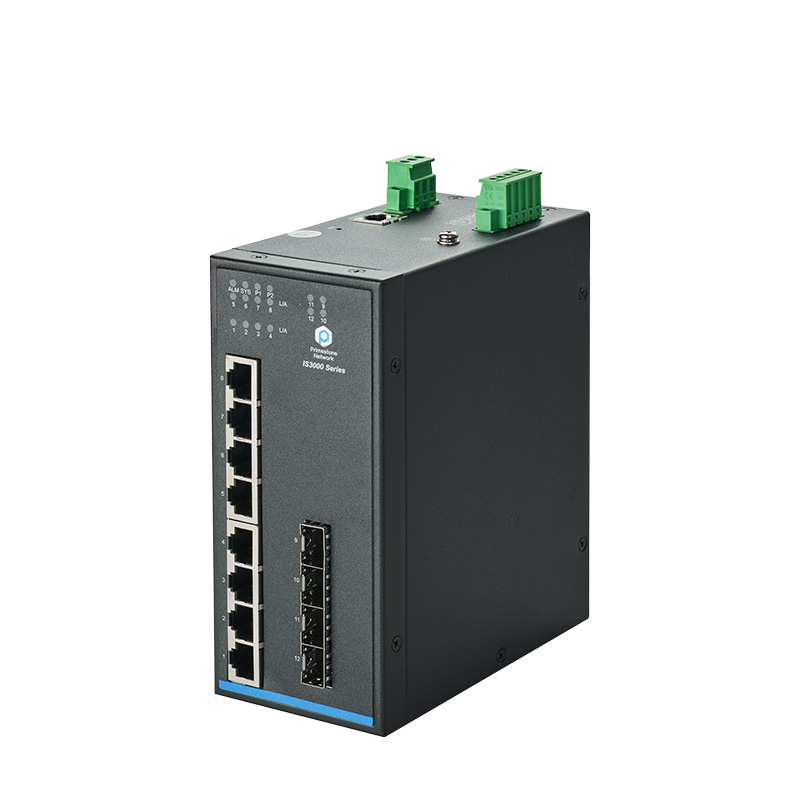In the field of industrial automation, the stability and reliability of networks are crucial. The redundancy and fault tolerance mechanism in the design of industrial Ethernet switches, which are the core components connecting various intelligent devices, are even more crucial. This article will delve into the design principles of redundancy and fault tolerance mechanisms in industrial Ethernet switches, as well as how these mechanisms play a key role in practical applications.
Redundancy design: as stable as Mount Tai
Redundancy design is a key measure to ensure stability in industrial Ethernet switches. Through redundant configuration, switches can quickly switch to backup paths in the event of hardware or network failures, achieving seamless switching and maintaining stable network operation. Redundant design mainly includes the following aspects:
1. Redundant power supply
Unstable power supply is a common problem in industrial environments, so the design of redundant power supply is particularly important. By configuring dual power inputs, when a power supply fails, the switch can automatically switch to a backup power supply to ensure continuous power supply to the device.
2. Redundant fans
Industrial Ethernet switches typically operate under harsh environmental conditions, and overheating is a potential issue. The design of redundant fans ensures that in the event of a fan failure, other fans can provide sufficient heat dissipation to ensure the normal operation of the equipment.
3. Redundant links
In network communication, the stability of the link is directly related to the reliability of data transmission. By setting up redundant links, when the main link fails, the switch can quickly switch to the backup link to avoid data transmission interruption.

Fault tolerance
Fault tolerance mechanism is an extension of redundant design, aimed at quickly detecting and responding to faults in the network through intelligent algorithms and technical means, ensuring the continuous and stable operation of the network. The following are some key design principles of fault-tolerant mechanisms:
1. Heartbeat detection
By regularly sending heartbeat signals in the network, industrial Ethernet switches can monitor the status of devices and links in real-time. Once an anomaly is detected, the system can quickly respond by initiating redundant paths to ensure network continuity.
2. Automatic recovery
The design of fault tolerance mechanism is not only about detecting faults, but also about how to quickly and automatically recover. The automatic recovery mechanism can automatically adjust the network topology and switch to a backup path after detecting a fault, reducing the impact of the fault on the entire network.
3. Packet resend
In industrial networks, packet loss can lead to serious problems. The retransmission of data packets in the fault-tolerant mechanism can ensure the complete transmission of data, and even in the event of temporary failures in the network, it can ensure the correct arrival of data at the destination through retransmission.
Actual case analysis
In order to better understand the effectiveness of redundancy and fault tolerance mechanisms in practical applications, let's take a manufacturing company as an example, which widely uses industrial Ethernet switches to support automated production lines.
In this production environment, industrial Ethernet switches ensure stable power supply to equipment through redundant design, and can maintain continuous operation even in the event of power failure. At the same time, industrial Ethernet switches are equipped with redundant links to ensure that production data can continue to be transmitted through backup links in the event of a failure in the main link, avoiding the risk of production interruption.
In addition, fault tolerance mechanisms have also played a crucial role. Through real-time heartbeat detection, industrial Ethernet switches can detect any potential faults in the production network and automatically start backup paths when faults occur, achieving fast and automatic network recovery.
Challenges and Future Prospects
Although redundancy and fault tolerance mechanisms have achieved significant success in industrial Ethernet switches, they still face some challenges. Firstly, devices from different manufacturers may adopt different redundancy and fault tolerance standards, leading to interoperability issues with the devices. Secondly, with the continuous expansion and upgrading of industrial networks, designing more intelligent and adaptable redundancy and fault tolerance mechanisms is the future development direction.
In the future, we can look forward to seeing more intelligent and reliable industrial Ethernet switches, which will further enhance network stability and provide stronger support for digital transformation in the field of industrial automation.
The redundancy and fault tolerance mechanism of industrial Ethernet switches is a powerful tool to ensure the stable operation of industrial networks. Through clever design, these mechanisms play a crucial role in power supply, links, data transmission, and other aspects, ensuring the continuity of industrial automation systems. In the future, with continuous technological innovation, we are confident in seeing more advanced industrial Ethernet switches.
Contact: sales
Phone: 18688787693
E-mail: sales@hsindustrialswitch.com
Add: Room 608, Building B,GaoXinQi TEC Park,Baoan District, ShenZhen,China